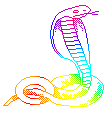| WEBMASTERS NOTE: The following three pages are a very informative series about keeping venomous snakes written by an online friend and extremely knowledgeable hot keeper...Allen Hunter. He has been kind enough to allow me to reproduce this series as part of the Cobra Information Series. Allen is solely responsible for the content and information presented on the next three pages. Please contact him (via the "Cobras Who's Who") with kudos, input or comments. Thanks Allen! Cobra Master |
HOUSING
* Venomous reptiles should be housed in solid, secure, locked
cages within a locked room.
* Cages should be constructed of strong, quality materials (1/2" plywood
min.) with no gaps or cracks large enough for newborn snakes to escape
from. A good rule of thumb here is, any crack or hole large enough for
the snake to put his snout in up to the eyes, is NOT secure. If it can
do this, it's gone- GUARANTEED!
* No cracked glass, bricks or lid weights, screen front cages or duct
tape. Ask me about the horrors of using duct tape in or on cages, including
what was probably the worst misjudgment mistake I've ever made. Besides,
it looks cheesy and doesn't impress anyone!
* The room itself MUST be absolutely sealed. You can't scrimp here
folks! This means using fine screening over air ducts and cracks along
the baseboards, sealing the bottom of room doors (incl. closets) and making
sure that windows fit snugly and are lockable. IT IS VITAL THAT THERE ARE
NO HOLES INTO THE WALLS OR BUILDING STRUCTURE!!
* Venomous snake rooms should be free of clutter and large immovable
cages should have the back end sealed against the wall so that fast and/or
agile species cannot run and hide behind them. Have as much floor area
as possible when working with hot snakes. Just try handling a cobra with
junk around your feet or getting a boomslang out from behind a 400lb. cage.
Fun? I think not!
* A good policy is to keep your handling tools and room light switch
on the wall just inside the door. You don't want to cross the room in the
dark to turn the lights on, and then step on something (alive) that wasn't
supposed to be there!
OTHER SAFETY MEASURES
* Label all cages with species and # of specimens. Such labels
should contain the scientific name, as common names can be misleading to
a toxicologist treating an exotic snakebite; e.g. 1.1 Saw-scale viper-Echis
carinatus pyramidium
* DO keep a posted list of emergency numbers in case of an accident.
If possible, have a phone installed in your snake room.
* NEVER pick up (freehandle) a venomous snake with your bare hands.
* NEVER work with hot reptiles while drunk, high on drugs or feeling
unwell. 80% of captive bites occur when someone who's hammered goofs-up.
* ALWAYS keep cages and room door locked when not in immediate use.
And never leave your keys out or loan them. Hide a spare set.
* DON'T involve inexperienced persons in handling hot snakes.
* BE DISCREET! Be selective who you speak to about them.
This list could go on, but most of it involves common sense. Keep your head about you, learn to "read" your snakes and hopefully all will be happy in Herpville! Part 2 will focus on tools for handling venomous snakes. Until next time- be safe and "Happy hooking!"
BIBLIOGRAPHY
* Phelps, T.- Poisonous Snakes.(1981) Blandford Press, London.
(A novice's Bible. A must, excellent!)
* Mehrtens, J.M.- Living Snakes of the World-In Colour (1987) Sterling
Publishing, New York (As above, with lots of Photos)
* Spawls, S.& Branch, B.- The Dangerous Snakes of Africa (1995)
Ralph Curtis Books, Florida. (If you love African hot snakes, this is THE
book!)
* Russell, F.E.,Phd.- Snake Venom Poisoning(1980)Scholium Int. Inc.,New
York
* Visser, J.& Chapman,D.S.-Snakes and Snakebite(1978)Purnell,Johannesburg,S.A.
(These last two books are sure to cure a case of complacency. Real
eye openers with excellent text, complete with graphic bite photos to make
you think!)
